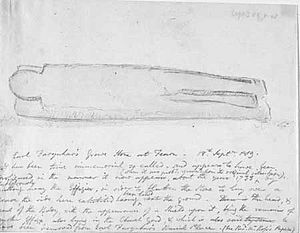Fearchar, Earl of Ross facts for kids
Fearchar of Ross (also known as Ferchar mac in tSagairt) was a very important person in Scottish history. He was the first Earl of Ross, a special title given to him by the King of Scotland in the 1200s. He helped bring the area of Ross under the control of the Scottish kings for the first time. Many people remember him as the founder of the Earldom of Ross. His family was called Ó Beólláin.
Contents
Who Was Fearchar?
For a long time, people believed Fearchar came from an old family called Ó Beólláin. This family was thought to be "co-arbs," which means they were like hereditary leaders or abbots of a church at Applecross in Ross-shire. This idea came from famous historians like William F. Skene.
However, a more recent historian, Alexander Grant, has a different idea. He thinks there isn't enough proof for the Applecross story. Instead, he believes Fearchar probably came from Easter Ross. Grant suggests that "mac an t-Sacairt" (which means "Son of the Priest") might mean Fearchar was in charge of a special holy place for Saint Duthac in Tain, Scotland.
Even though "Ross" became the name of the land the Earls ruled, old records show that the Earls of Ross were first known by the surname Ó Beólláin. For example, a person named Hugh Beolan, Earl of Ross, was recorded in 1333. The Ó Beólláin surname was used for the Earls of Ross until 1372. Later, the name "Ross" became the surname for the Earls, much like the Royal Family in England later used "Windsor."
Fearchar's Rise to Power
Experts believe Fearchar was a local nobleman who became powerful by supporting the King of Scots. We first hear about Fearchar in 1215. At that time, he was a local leader who stopped a big rebellion against the Scottish king, Alexander II.
The Chronicle of Melrose, an old historical record, said that Fearchar "attacked them and mightily overthrew the king's enemies." It also said he "cut off their heads and presented them as gifts to the new king." Because of this brave act, "the lord king appointed him a new knight."
Fearchar's ability to defeat powerful groups like the Meic Uilleim and MacHeths shows he had a lot of military strength. This power probably came from his local influence, even if he was also a hereditary priest. The Scottish kings also had some power in Ross, which helped Fearchar gain support.
Becoming the Earl of Ross
It's possible that King Alexander II made Fearchar an Earl (or Mormaer) when he visited Inverness in 1221. However, some historians think it might have been a bit later, perhaps around 1226. We know for sure he was an Earl by 1232. In that year, his name appeared in a special document called a charter, where he was called Comes de Ross, which means Mormaer of Ross.
Some people wonder if Fearchar was a "novus homo" (a "new man" who came from nothing). We don't know what happened to the Earldom of Ross after the last known Earl, Malcolm MacHeth, died in 1168. It's likely that Fearchar was already a strong local leader. The King simply made his power official by giving him the title of Earl. This helped connect the local Gaelic leaders to the King's government.
Fearchar and Scotland's King
In 1235, Fearchar helped the King again in Galloway. There was a rebellion led by Gille Ruadh. King Alexander's army was almost defeated, but Fearchar arrived with the "Men of Ross" and saved the King.
This event was similar to an earlier time in 1187, when another Gaelic lord helped defeat a rebel. Fearchar's actions showed his loyalty and importance to the Scottish King.
Fearchar was also present at important talks that led to the Treaty of York, which was signed in 1237. This treaty helped define the border between Scotland and England.
Family Connections
Fearchar had at least two daughters who made important marriages. One daughter, Euphemia, married Walter de Moravia, a powerful lord from Duffus. Walter's family was from Flanders (modern-day Belgium) and had been settled in Scotland by the King to help control the area of Moray.
Another daughter, Christina, married Olaf the Black, who was the King of Mann and the Isles. This marriage happened sometime before 1223. This was a smart move because the King of Mann ruled over the Isle of Skye, which was close to Ross. These marriages show that Fearchar was not just a local leader. He was an ambitious Gaelic warlord who wanted to have influence in the wider Norse-Gaelic world, which included areas around the Irish Sea.
Supporting the Church
Fearchar also showed his connections by supporting the church. In the 1220s, he gave land to the Premonstratensian Order, a group of monks, to build a new monastery at Mid Fearn in Ross. A decade later, he moved it to New Fearn. The monks brought some holy items of St Ninian with them. This is why Fearn Abbey is still connected to that saint today. Building a monastery was a common way for powerful lords to show their importance and religious devotion.
When Did Fearchar Die?
We don't know the exact year Fearchar died. The traditional date, 1251, comes from an old book that isn't always reliable. However, we do know for sure that he had died by the 1250s, because his son became the Earl of Ross around that time.


